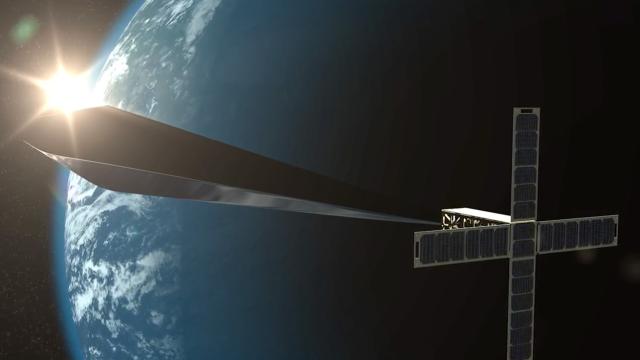As if there isn’t already enough junk in space, an artist is planning to launch a reflective, inflatable sculpture to low Earth orbit in October. The art piece is meant to instil a sense of wonder and alter humanity’s impression of itself, but in reality it’s an empty gesture that’ll only serve to infuriate astronomers.
It’s called the Orbital Reflector and it’s the brainchild of US artist Trevor Paglen. Once it’s unfurled and fully erect, the space-based sculpture will be visible in the night sky, appearing as a fast-moving bright star. Paglen’s installation will stay in low Earth orbit for a minimum of 60 days (though it could be longer), after which time it will, mercifully, re-enter the atmosphere and burn to a crisp.
[referenced url=”https://gizmodo.com.au/2018/01/astronomers-say-giant-disco-ball-in-space-sets-a-bad-precedentone-that-could-hurt-science/” thumb=”https://i.kinja-img.com/gawker-media/image/upload/t_ku-large/nxbtfqarjklxnyrgby2p.jpg” title=”Astronomers Say Giant Disco Ball In Space Is Bad For Science” excerpt=”Last week, rocket startup Rocket Lab launched a 91cm-wide mirror ball into orbit. Called “Humanity Star”, it’s supposed to remind us that we’re all puny specks of dust living in the terrifying vastness of the Universe.”]
Unfortunately, it will be the second time this year that an artist has sent a reflective sculpture into space. Back in January, Rocket Lab CEO Peter Beck placed his three-foot-wide mirror ball, called Humanity Star, into orbit, attracting the ire of scientists, who complained that the bright object might interfere with astronomical observations. Sending twinkly, useless objects into orbit is apparently trendy now.
As Jonathan McDowell, an astrophysicist at the Harvard-Smithsonian Center for Astrophysics, told Gizmodo earlier this year, “It’s the space equivalent of someone putting a neon advertising billboard right outside your bedroom window”. Indeed, Paglen’s Orbital Reflector, which is about the length of a football field, has the potential to be even more annoying than Beck’s disco ball, despite its potentially brief life.
The diamond-shaped sculpture is made from a lightweight material similar to Mylar and it’ll be packed inside a CubeSat. The satellite itself will be integrated into a low free flyer, a device that’ll be placed into a SpaceX Falcon 9 rocket. Once in low Earth orbit, the free flyers will dispense over 70 satellites at various intervals, including the CubeSat containing the collapsed sculpture.
Following deployment, the sculpture should inflate into a large reflective balloon, orbiting the planet at a height of 575km once every 90 minutes. Paglen has teamed up with the Nevada Museum of Art, Spaceflight Industries and engineers from Global Western, a small, independent aerospace firm, to make this project happen. Launch of the Falcon 9 is expected in late October.
For the project, Paglen and his colleagues had to secure the same levels of approval as required of any other CubeSat being transported to low Earth orbit, including getting a licence from the US Federal Communications Commission (FCC) and meeting regulations set out by International Traffic in Arms Regulations (ITAR). The group has also been in touch with the US Air Force.
Paglen says his sculpture will change the way we see ourselves, while reminding us of the many “invisible” satellites already in orbit.
“As the twenty-first century unfolds and gives rise to unsettled global tensions, Orbital Reflector encourages all of us to look up at the night sky with a renewed sense of wonder, to consider our place in the universe and to reimagine how we live together on this planet”, writes Paglen at the Orbital Reflector website. “While most of us realise that everyday satellites link telecommunications systems, financial and transportation infrastructure and military functions around the globe, it is sometimes easy to forget these all-but-invisible activities. After all, they happen up there in outer space — out of sight, out of mind”.
Ah, nothing like sending a non-functional satellite into an already crowded region of space to remind us of all the satellites already in low Earth orbit. Someone needs to tell Paglen that many satellites, including the ISS, are in fact visible to the naked eye; an extra dot in the night sky for several weeks will hardly transform humanity’s impression of itself.
Amanda Horn, the director of communications for the Nevada Museum of Art, doesn’t see it that way.
“We may not always realise it, but art helps us change the way we see ourselves”, Horn told Gizmodo. “As Trevor says, art gives us permission to look at things, to imagine a different future, to reconsider the past. Orbital Reflector is a temporary gesture in the night sky, so it is a moment in time and space that makes visible the invisible, thereby rekindling our imaginations and fuelling potential for the future”.
Horn says art is often subjective, “so any criticism for this project is not different from myriad critiques of other art projects”. That said, she says any potential disruption to astronomy will be minimal and temporary.
It’s getting easier and cheaper to put objects into orbit, which explains why artists are now using space as their canvas. Rocket companies like SpaceX, Spaceflight Industries and Rocket Lab stand to profit from ferrying mini-satellites to orbit, which means they have little incentive to question such endeavours.
Given this new era of access, government agencies may need to determine new standards for what gets to go into space and what doesn’t. On it’s own, Paglen’s Orbital Reflector won’t pose a problem, but given that it’s the second flashy sculpture to go into orbit this year, we may soon see a lot more of these projects.
Maintaining a clean, unhindered low Earth orbit and upholding the needs of science should take precedence over gestures such as these.
